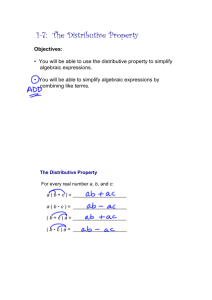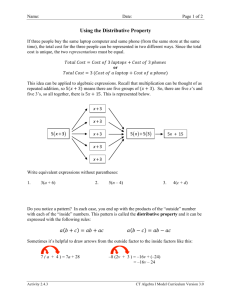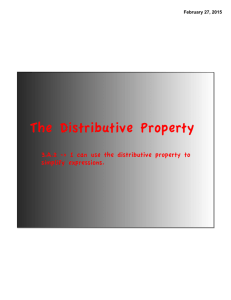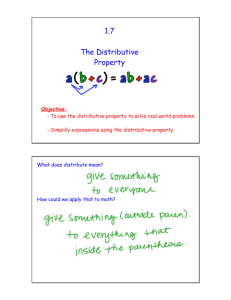Order of Operations with Algebraic Expressions Student Probe Less
advertisement
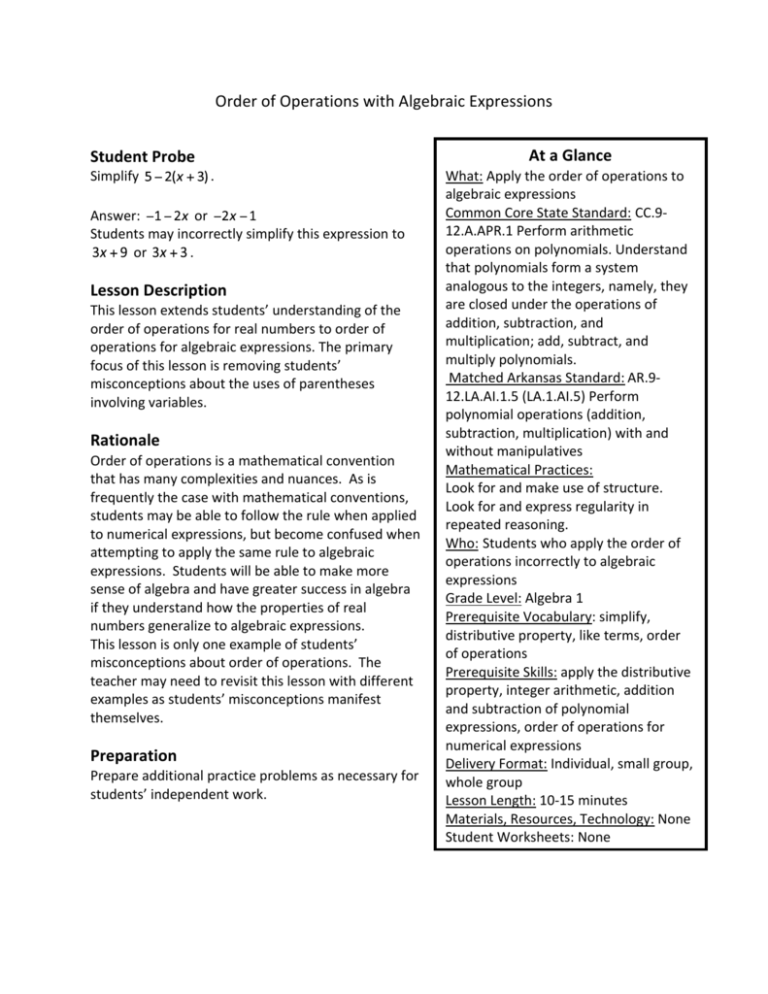
Order of Operations with Algebraic Expressions Student Probe Simplify . Answer: or Students may incorrectly simplify this expression to or . Lesson Description This lesson extends students’ understanding of the order of operations for real numbers to order of operations for algebraic expressions. The primary focus of this lesson is removing students’ misconceptions about the uses of parentheses involving variables. Rationale Order of operations is a mathematical convention that has many complexities and nuances. As is frequently the case with mathematical conventions, students may be able to follow the rule when applied to numerical expressions, but become confused when attempting to apply the same rule to algebraic expressions. Students will be able to make more sense of algebra and have greater success in algebra if they understand how the properties of real numbers generalize to algebraic expressions. This lesson is only one example of students’ misconceptions about order of operations. The teacher may need to revisit this lesson with different examples as students’ misconceptions manifest themselves. Preparation Prepare additional practice problems as necessary for students’ independent work. At a Glance What: Apply the order of operations to algebraic expressions Common Core State Standard: CC.9-­‐ 12.A.APR.1 Perform arithmetic operations on polynomials. Understand that polynomials form a system analogous to the integers, namely, they are closed under the operations of addition, subtraction, and multiplication; add, subtract, and multiply polynomials. Matched Arkansas Standard: AR.9-­‐ 12.LA.AI.1.5 (LA.1.AI.5) Perform polynomial operations (addition, subtraction, multiplication) with and without manipulatives Mathematical Practices: Look for and make use of structure. Look for and express regularity in repeated reasoning. Who: Students who apply the order of operations incorrectly to algebraic expressions Grade Level: Algebra 1 Prerequisite Vocabulary: simplify, distributive property, like terms, order of operations Prerequisite Skills: apply the distributive property, integer arithmetic, addition and subtraction of polynomial expressions, order of operations for numerical expressions Delivery Format: Individual, small group, whole group Lesson Length: 10-­‐15 minutes Materials, Resources, Technology: None Student Worksheets: None Lesson The teacher says or does… 1. Let’s simplify the expression . Explain what you did. 2. So how can we simplify ? Does the method we just used work for this expression? Why or why not? 3. Now let’s try . 4. What do we do first to simplify ? 5. Now let’s simplify using the distributive property. 6. Simplify . Expect students to say or do… or No, because we can only add like terms. If students do not, then the teacher says or does… Do you remember using the order of operations? Do you remember when we used the distributive property? Could we use it here? You may refer to Distributive Property. Refer to Addition and Subtraction of Polynomials. Refer to Distributive Property Use the distributive property or “get rid of” the parentheses. = Review order of operations for numerical expressions. Remind students about like terms. If students incorrectly calculate , refer to Integer Operations If students answer (or ), then use the counterexample , not . Teacher Notes 1. The use of the mnemonic device PEMDAS (or Please Excuse My Dear Aunt Sally) to stand for “parentheses, exponents, multiplication, division, addition, and subtraction” should be minimized. While it can serve students well when dealing with relatively simple numerical expressions, it can become a limiting factor as they progress through algebra courses. 2. Students who rely on PEMDAS frequently have the misconception that multiplication is always done before division and addition is always done before subtraction, rather than in order as they occur from left to right. Also in the numerical expression , the operation within the parentheses can be performed first. However in the algebraic expression the operation within the parentheses cannot be performed first. There are many grouping symbols in mathematics other than parentheses, such as the fraction bar. In the expression , the addition must take place before the division. Similarity, in the expression , the radical acts as a grouping symbol. 3. As students’ misconceptions about the use of the correct order of operations emerge, teachers may need to revisit this intervention lesson using appropriate examples. Variations Some examples of students’ frequent misconceptions involving order of operations are listed below. The teacher may need to revisit this lesson using different examples as students’ misconceptions manifest themselves. 1. 2. 3. 4. Formative Assessment Simplify . Answer: References Mathematics Preparation for Algebra. (n.d.). Retrieved December 10, 2010, from Doing What Works: http://dww.ed.gov/practice/?T_ID=20&P_ID=48 Russell Gersten, P. (n.d.). RTI and Mathematics IES Practice Guide -­‐ Response to Intervention in Mathematics. Retrieved 2 25, 2011, from rti4sucess: http://www.rti4success.org/images/stories/webinar/rti_and_mathematics_webinar_presentati on.pdf

